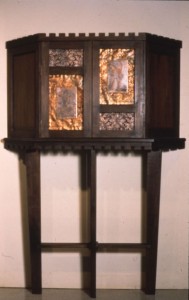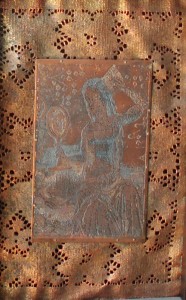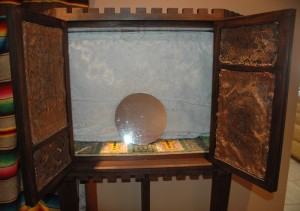In the Collection of Helen Klebesadel
Since I’ve bounced from brooms to cauldrons, them mirrors, I thought I’d introduce one of Rae’s Cabinets. The Whore, as she affectionately called it, is now in the Collection of Helen Klebesadel. It consists of a solid black walnut cabinet on a walnut base, with copper panels filling the doorframes. The top of the cabinet is a fairly good example of standard cabinetry, albeit with some odd angles, since from above it forms an isosceles trapezoid. The base is unusual in that it appears to be on tip-toe, its four legs including two widely spaced to the sides, and two very close together front and back, all tapered to be smaller at the floor.. The top edge of the cabinet, and the skirt of the base are crenellated, reminiscent of castle fortifications.
The design was intended to look medieval, for a couple of reasons. In keeping with reclaiming objects of domesticity and power, in her researches Rae discovered references to the cabinets in feudal households, wherein the wealth of the house was kept (often that meant the few coins they might have, but certainly the precious and rare papers, and the best of the clothing, which often represented the real wealth of the household, in embroidered and beaded dresses and such. The lady of the house would have the keys to this, often the only locked container in the home. The walnut was stained dark, and the wood slightly distressed to make it look older and well used.
The copper in the doors consists of two lace doilies, and two engravings on lace frames. They were created using two different techniques, one of which (electroforming) Rae experimented with quite a bit, and created some beautiful pieces I’ll show later, the other was just for this piece. The latter was acid etching of an image.
When she decided to use images and symbology from the Book of Revelation, specifically the Whore of Babylon, she found a couple of woodcuts, created a photo-resist image on a sheet of copper of each, and then let acid etch away some of the copper, making a relief image in the copper.
The lace was actual lace doilies, stiffened slightly with wax, with a thin layer of metallic copper paint spread on them. The electroforming process involved a large tank, thick ingots of copper attached to a positive electrode, and the lace with the copper paint had wires attached, connected to a negative electrode, and the lace suspended in a bath of copper electrolyte solution from a bar that moved gently back and forth in the solution. Copper ions came off the ingots, through the solution, and onto the lace, until they were thick enough for her purposes. Usually the “mandrel” or form is then removed, but Rae had put copper on both sides of the lace, so it is still trapped within.
The two pieces that back the images were attached to them using copper rivets, and the whole then re-immersed, to join them together, stopping when the etched images started to lose definition.
The inside of the cabinet has a glass tile mosaic on the floor, a circular mirror reflecting the viewer, and a lace lining.
I know Rae did a lot of reading and collecting material about Revelation, and some of the many interpretations of that work. I don’t have a lot of it in my head, though, so can’t really give too much more. Like many if not all of her pieces, though, there are layers of meaning that she intended, and even more that are invoked in the viewer. Maybe you can see it at Helen’s sometime.





This was one of my favorite pieces of hers. Thanks for posting this.
Comment by Jen — October 26, 2009 @ 6:31 am